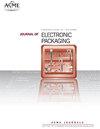喷墨金属化表面贴装印刷铜的工艺开发
IF 2.3
4区 工程技术
Q3 ENGINEERING, ELECTRICAL & ELECTRONIC
引用次数: 4
摘要
印刷电子是一项发展最快的新兴技术,在汽车、可穿戴设备、医疗保健和航空航天等多个行业都显示出巨大潜力。它的应用不仅可以在柔性中找到,而且可以在大面积电子中找到。喷墨技术因其低成本、低材料消耗和大规模制造能力而备受关注。优选的导电金属主要是银,这是由于其优异的电性能和易于烧结。然而,银变得比铜贵。由于铜容易被氧化,因此人们非常关注光子烧结,该烧结涉及在一定能量下突然爆发脉冲光来烧结铜纳米颗粒。使用这种技术,只有印刷材料在几秒钟内被烧结,而不会对其基底产生很大影响。根据所有的知识,在与铜的工艺方面仍然存在很大的差距,了解印刷工艺如何影响铜的电气和机械性能很重要。随着工艺的发展,发现印刷铜的电阻率是大块铜的5倍。关于与聚酰亚胺膜的粘合,发现失效的机械剪切载荷在15-20gF范围内。为了证明完整的工艺,商用现成组件也安装在额外印刷的焊盘上。从统计学上讲,控制图表技术是用来理解印刷品长时间内的任何工艺变化的。本文章由计算机程序翻译,如有差异,请以英文原文为准。
Process Development for Printed Copper with Surface Mount Devices On Inkjet Metallization
Printed electronics is a fastest growing and emerging technology that have shown much potential in several industries including automotive, wearables, healthcare, and aerospace. Its applications can be found not only in flexible but also in large area electronics. Inkjet technology has gained much attention due to its low-cost, low material consumption, and capability for mass manufacturing. The preferred conductive metal of choice has been mostly silver due to its excellent electrical properties and ease in sintering. However, silver comes to be expensive than its counterpart copper. Since copper is prone to oxidation, much focus has been given towards photonic sintering that involves sudden burst of pulsed light at certain energy to sinter the copper Nanoparticles. With this technique, only the printed material gets sintered in a matter of seconds without having a great impact on its substrate. With all the knowledge, there is still a large gap in the process side with copper where it is important to look how the print process affects the electrical and mechanical properties of copper. With the process developed, the resistivity of printed copper was found to be 5 times the bulk copper. In regards to adhesion to the polyimide film, mechanical shear load to failure was found to be within 15-20 gF. To demonstrate the complete process, commercial-off-the-shelf components are also mounted on the additively printed pads. Statistically, control charting technique is implemented to understand any process variation over long duration of prints.
求助全文
通过发布文献求助,成功后即可免费获取论文全文。
去求助
来源期刊

Journal of Electronic Packaging
工程技术-工程:电子与电气
CiteScore
4.90
自引率
6.20%
发文量
44
审稿时长
3 months
期刊介绍:
The Journal of Electronic Packaging publishes papers that use experimental and theoretical (analytical and computer-aided) methods, approaches, and techniques to address and solve various mechanical, materials, and reliability problems encountered in the analysis, design, manufacturing, testing, and operation of electronic and photonics components, devices, and systems.
Scope: Microsystems packaging; Systems integration; Flexible electronics; Materials with nano structures and in general small scale systems.
 求助内容:
求助内容: 应助结果提醒方式:
应助结果提醒方式:


